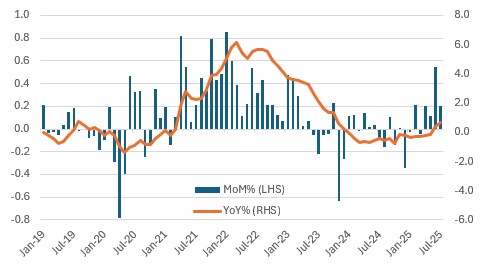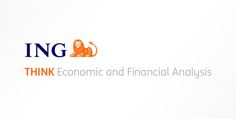Walmart halts H-1B visa offers amid Trump’s $100,000 fee increase - Bloomberg
Inflation was broadly in line with expectations as tariffs continue to be largely absorbed within US corporate profit margins. This gives the Fed the room to respond to the weaker jobs backdrop and cut interest rates from September
Tariff Effect Wanes And Keeps Inflation In Check
US July Consumer Price Inflation came in largely as expected with headline CPI rising 0.2% month-on-month and CPI rose 2.7% year-on-year and Core CPI rising 0.3% MoM and Core CPI rose 3.1% YoY. The details show energy prices fell 1.1% MoM while food was flat on the month. In terms of the sectors most exposed to tariffs things looked fairly benign. Core goods ex autos rose 0.2% MoM after jumping 0.55% MoM in June suggesting, that for now at least, corporates are absorbing most of the tariff cost. Appliances surprisingly fell 0.9%, apparel rose 0.1%, sporting goods rose 0.4% with furniture up 0.9%.
Core Goods Ex Autos Inflation

Source: Macrobond, ING
New vehicle prices were unchanged on the month, despite being exposed to significant tariffs, while used vehicles rose 0.5% after four consecutive monthly declines. Services were a little stronger, boosted by a 4% MoM jump in airline fares and a 0.7% increase in medical care costs. However shelter was encouragingly subdued, rising only 0.2% MoM.
Falling house prices and cooling rent data points to this major component mitigating much of the threat from tariffs with inflation unlikely to breach 4% YoY this autumn with a growing chance that it actually falls below 2% late next year.
Weaker Housing, Energy and Wage Costs Suggest Downside Inflation Risks for 2026
The ISM price components still suggest there may be a linger inflation threat from tariffs, but today’s NFIB survey suggests that small businesses are struggling to pass those costs onto customers with the net proportion of firms expecting to raise prices in the coming three months dropping from 32% to 28%.
Many prices will end up rising in time due to tariffs, but we don’t see inflation pressures persisting. We are in a very different situation to 2021/22 when inflation soared to 9%. Back then oil prices also tripled over that period, house prices and housing rents surged, while the jobs market was red hot with desperate hiring practices resulting in record employee turnover as wages soared. This all helped to amplify and extend the post-Covid supply-shock-related increase in goods prices. Today, these are all disinflationary influences, with cooling housing rents in particular set to help offset the effect of tariffs over the coming quarters.
With the jobs market not looking as solid as it did earlier in the year and consensus GDP growth forecasts having been cut from 2.5% at the beginning of this year down to 1.5% we believe the Fed will cut the policy rate in September and follow up with additional 25bp cuts in October and December.
***
Disclaimer: This publication has been prepared by ING solely for information purposes irrespective of a particular user’s means, financial situation or investment objectives. The information does not constitute investment recommendation, and nor is it investment, legal or tax advice or an offer or solicitation to purchase or sell any financial instrument. Read more
